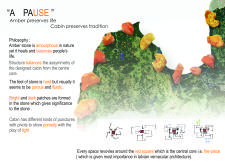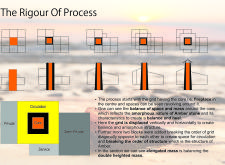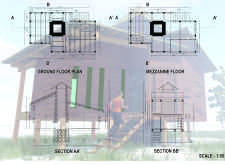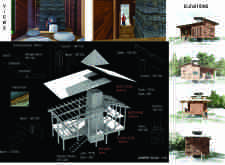5 key facts about this project
At the heart of the project is the concept of blending indoor and outdoor spaces, fostering a seamless connection with nature. Large, transparent facades allow natural light to permeate the interiors, blurring the lines between built and natural environments. This use of transparency not only enhances the aesthetic experience but also promotes energy efficiency by reducing the reliance on artificial lighting during daytime hours. The design prioritizes sustainability, employing passive solar heating and cross-ventilation strategies that optimize comfort while minimizing energy consumption.
The architectural design features a harmonious balance between various materials, which play a significant role in conveying the project's identity. Predominantly, the structure utilizes a combination of concrete, glass, and wood, each serving a distinct purpose. The concrete provides structural integrity and longevity, while the glass facilitates an open atmosphere that welcomes the surrounding landscape into the living spaces. Wood is strategically placed, offering warmth and an organic touch, reinforcing the intention of connecting with nature.
Unique design approaches are evident throughout the layout, particularly in the arrangement of spaces. The floor plan promotes flexibility, allowing for multifunctional areas that can adapt to changing needs. Open-concept living spaces are complemented by more secluded areas designed for privacy, catering to diverse activities and preferences. The careful consideration of flow between these spaces reflects an understanding of contemporary lifestyle requirements while encouraging social interaction.
Furthermore, the project includes landscaped areas that enhance the overall experience. Outdoor patios and green roofs serve as extensions of the interior spaces, inviting occupants to engage with the environment in a tranquil setting. These landscapes are not merely decorative; they contribute to the building's sustainability by improving insulation and reducing stormwater runoff. The selection of native plants for the landscaping underscores a commitment to ecological responsibility and local biodiversity.
The project also integrates the latest technologies to enhance user experience and energy efficiency. Smart home systems have been incorporated to control lighting, heating, and security, allowing residents to manage their environments intuitively. This technological advancement aligns with modern expectations for convenience and efficiency in day-to-day living.
In summary, this architectural project represents a synthesis of innovative design, sustainability, and community engagement. It embodies the principles of contemporary architecture while addressing the practical needs of its users. Each element, from materials to layout, has been meticulously considered to create a harmonious living environment that fosters both connection and independence. For those interested in exploring the nuances of this project, a deeper look at architectural plans, architectural sections, and architectural ideas will provide further insights into its design and functional aspects. Engaging with the detailed presentations of this project will enhance understanding and appreciation of its architectural significance.


























